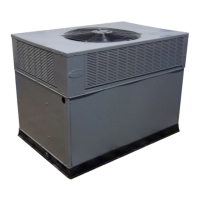superheat charging method for evaluating the unit charge. Do not
use mercury or small dial-type thermometers because they are not
adequate for this type of measurement.
IMPORTANT: When evaluating the refrigerant charge, an indi-
cated adjustment to the specified factory charge must always be
very minimal. If a substantial adjustment is indicated, an abnormal
condition exists somewhere in the cooling system, such as insuf-
ficient airflow across either coil or both coils.
REFRIGERANT CHARGE — The amount of refrigerant charge
is listed on the unit nameplate. Refer to Carrier Refrigeration
Service Techniques Manual, Refrigerants section.
Unit panels must be in place when unit is operating during
charging procedures.
NO CHARGE: Use standard evacuating techniques. After evacu-
ating system, weigh in the specified amount of refrigerant (refer to
system data plate).
LOW CHARGE COOLING: Measure outdoor ambient using
Cooling Charging Charts (Figs. 23-28). Vary refrigerant until the
conditions of the chart are met. Note that charging charts are
different from type normally used. Charts are based on charging
the units to correct superheat for the various operating conditions.
Accurate pressure gage and temperature sensing devices are
required. Connect the pressure gage to the service port on the
suction line. Mount the temperature sensing device on the suction
line and insulate it so that the outdoor ambient does not effect the
reading. Indoor air CFM must be within the normal operating
range of the unit.
TO USE COOLING CHARGING CHARTS: Take the outdoor
ambient temperature and read the suction pressure gage. Refer to
the chart to determine what the suction temperature should be.
NOTE: If the problem causing the inaccurate readings is a
refrigerant leak, refer to Check for Refrigerant Leaks section in
this document.
INDOOR AIRFLOW AND AIRFLOW ADJUSTMENTS
For cooling operation, the recommended airflow is 350 to 450
cfm for each 12,000 Btuh of rated cooling capacity. For
heating operation, the airflow must produce a temperature rise
that falls within the range stamped on the unit rating plate.
Table 7 shows the temperature rise at various air-flow rates. Table
9 shows both heating and cooling airflows at various external static
pressures. Refer to these tables to determine the airflow for the
system being installed.
NOTE: Be sure that all supply- and return-air grilles are open,
free from obstructions, and adjusted properly.
Shut off gas supply then disconnect electrical power to the
unit before changing blower speed. Electrical shock or
explosion could cause serious injury or death.
Airflow can be changed by changing the lead connections of the
blower motor.
All 48GP units are factory wired for low speed and may need to be
wired for medium or high speed in the field.
For 208/230-v — The motor leads are color-coded as follows:
3-SPEED 2-SPEED
black = high speed black = high speed
blue = medium speed ---
red = low speed red = low speed
To change the speed of the blower motor (BM), remove the fan
motor speed leg lead from the blower relay (BR). This wire is
attached to terminal BM for single-phase and 3-phase units. To
change the speed, remove and replace with lead for desired blower
motor speed. Insulate the removed lead to avoid contact with
chassis parts.
For 460-v GE Motors — The motor leads are color coded as
follows:
3-SPEED 2-SPEED
black = high black = high
violet = jumper blue = jumper
orange = medium ---
red = low red = low
To change the speed of the blower motor (BM), remove fan motor
speed lead from the blower relay (BR) and replace with the lead
for the desired blower motor speed. The motor speed lead is
attached to terminal BM. For low and medium speeds black must
be connected to the jumper wire. Insulate removed lead end to
avoid contact with chassis parts. To select high speed on 460-v GE
motors, separate the black female quick connect (QC) from the
jumper lead male quick connect (QC) and connect the black lead
to the BR. Insulate the jumper to avoid contact with any chassis
parts.
20

